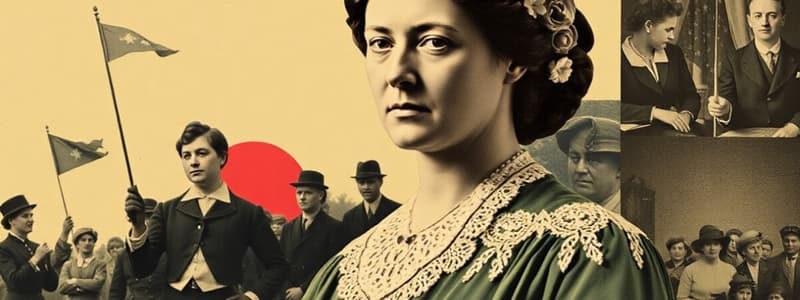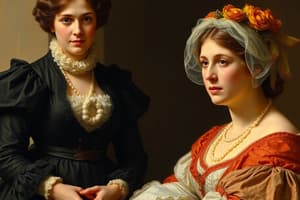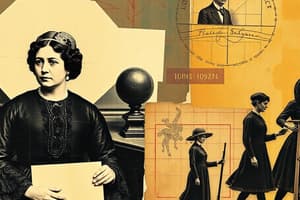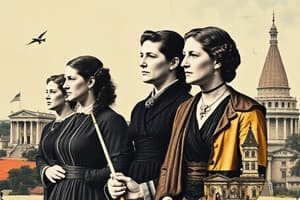Podcast
Questions and Answers
What was the primary difference between the National Woman Suffrage Association and the American Woman Suffrage Association?
What was the primary difference between the National Woman Suffrage Association and the American Woman Suffrage Association?
- The National Association supported the Fifteenth Amendment while the American Association opposed it.
- The American Association focused on lobbying state by state, whereas the National Association lobbied for a federal amendment.
- The National Association was founded in the 1850s while the American Association was formed in the 1870s.
- The National Association wanted no more men to get the vote before women did, while the American supported the Fifteenth Amendment. (correct)
What tactic did some suffragists advocate for as the movement progressed into the 1900s?
What tactic did some suffragists advocate for as the movement progressed into the 1900s?
- Continuing to lobby state by state in areas where women had been granted the vote. (correct)
- Picketing and militancy at political meetings only.
- Forming alliances only with African American organizations.
- Focusing exclusively on federal legislation for women's voting rights.
How did Elizabeth Cady Stanton's views on African American men contribute to controversy within the women's suffrage movement?
How did Elizabeth Cady Stanton's views on African American men contribute to controversy within the women's suffrage movement?
- She advocated for African American suffrage at the expense of white women's rights.
- She believed African American men were more deserving of the vote than white women.
- She insulted African American men, suggesting they were unworthy of the vote. (correct)
- She argued that the vote should be given to African American men and women equally.
Which event did Elizabeth Cady Stanton participate in to advocate for women's suffrage?
Which event did Elizabeth Cady Stanton participate in to advocate for women's suffrage?
What was one of Elizabeth Cady Stanton's significant contributions to the suffrage movement?
What was one of Elizabeth Cady Stanton's significant contributions to the suffrage movement?
What motivated Elizabeth Cady Stanton to rebel against traditional gender roles?
What motivated Elizabeth Cady Stanton to rebel against traditional gender roles?
How did Elizabeth Cady Stanton's marriage differ from conventional practices of her time?
How did Elizabeth Cady Stanton's marriage differ from conventional practices of her time?
What event led Elizabeth to meet Lucretia Mott?
What event led Elizabeth to meet Lucretia Mott?
What did Elizabeth Cady Stanton do after the male delegates voted to exclude women at the convention?
What did Elizabeth Cady Stanton do after the male delegates voted to exclude women at the convention?
What was the purpose of Elizabeth Cady Stanton's book, The Woman's Bible?
What was the purpose of Elizabeth Cady Stanton's book, The Woman's Bible?
What aspect of Elizabeth's childhood influenced her view on women's rights?
What aspect of Elizabeth's childhood influenced her view on women's rights?
How did Elizabeth Cady Stanton view the clergymen at the convention?
How did Elizabeth Cady Stanton view the clergymen at the convention?
What did Elizabeth Cady Stanton do to express her frustration with the law regarding women's inheritance?
What did Elizabeth Cady Stanton do to express her frustration with the law regarding women's inheritance?
What feeling did Elizabeth Cady Stanton express about being a mother?
What feeling did Elizabeth Cady Stanton express about being a mother?
What significant event did Elizabeth help plan in 1848?
What significant event did Elizabeth help plan in 1848?
What role did Susan B. Anthony play in the partnership with Elizabeth Cady Stanton?
What role did Susan B. Anthony play in the partnership with Elizabeth Cady Stanton?
What was the primary goal of the women's suffrage movement as expressed by Elizabeth?
What was the primary goal of the women's suffrage movement as expressed by Elizabeth?
What tension arose between Elizabeth and Susan during their partnership?
What tension arose between Elizabeth and Susan during their partnership?
How did Elizabeth and Susan's views on African American men and women's enfranchisement evolve after the Civil War?
How did Elizabeth and Susan's views on African American men and women's enfranchisement evolve after the Civil War?
What dynamic characterized the friendship between Elizabeth and Susan?
What dynamic characterized the friendship between Elizabeth and Susan?
What differing priorities emerged within the suffrage movement during the Civil War?
What differing priorities emerged within the suffrage movement during the Civil War?
Flashcards
Elizabeth's Early Encounter with Injustice
Elizabeth's Early Encounter with Injustice
A young Elizabeth Cady Stanton witnessed firsthand the injustice faced by women due to legal limitations, solidifying her early commitment to advocating for women's rights.
Rejecting Traditional Gender Roles
Rejecting Traditional Gender Roles
Elizabeth Cady Stanton defied societal norms by refusing to obey her husband and choosing to be known by her own name, Elizabeth., not as 'Mrs. Henry Stanton.'
Meeting Lucretia Mott: A Turning Point
Meeting Lucretia Mott: A Turning Point
Elizabeth Cady Stanton, a strong advocate for women's rights, was inspired by her meeting with Lucretia Mott at the World Anti-Slavery Convention in London, recognizing the common struggles faced by women and the need for collective action.
Challenging the Woman's Bible
Challenging the Woman's Bible
Signup and view all the flashcards
Exclusion from the World Anti-Slavery Convention
Exclusion from the World Anti-Slavery Convention
Signup and view all the flashcards
Early Influences on Elizabeth's Activism
Early Influences on Elizabeth's Activism
Signup and view all the flashcards
Fighting for Equality in Personal Life
Fighting for Equality in Personal Life
Signup and view all the flashcards
Elizabeth's Commitment to Justice
Elizabeth's Commitment to Justice
Signup and view all the flashcards
Who was Elizabeth Cady Stanton?
Who was Elizabeth Cady Stanton?
Signup and view all the flashcards
What was the Seneca Falls Convention?
What was the Seneca Falls Convention?
Signup and view all the flashcards
What was the Declaration of Sentiments?
What was the Declaration of Sentiments?
Signup and view all the flashcards
What was the relationship between Elizabeth Cady Stanton and Susan B. Anthony?
What was the relationship between Elizabeth Cady Stanton and Susan B. Anthony?
Signup and view all the flashcards
What divisions existed within the suffrage movement?
What divisions existed within the suffrage movement?
Signup and view all the flashcards
What were the differences between Elizabeth Cady Stanton and Susan B. Anthony?
What were the differences between Elizabeth Cady Stanton and Susan B. Anthony?
Signup and view all the flashcards
What challenges did the suffrage movement face?
What challenges did the suffrage movement face?
Signup and view all the flashcards
What was the impact of the suffrage movement?
What was the impact of the suffrage movement?
Signup and view all the flashcards
Split over voting rights for Black men
Split over voting rights for Black men
Signup and view all the flashcards
Division over tactics
Division over tactics
Signup and view all the flashcards
Elizabeth Cady Stanton
Elizabeth Cady Stanton
Signup and view all the flashcards
Running for Congress
Running for Congress
Signup and view all the flashcards
Stanton's impact
Stanton's impact
Signup and view all the flashcards
Study Notes
Elizabeth Cady Stanton
- Born November 12, 1815 – October 26, 1902
- Daughter of a lawyer in Johnstown, NY
- Witnessing her father's inability to help a woman facing loss of property after her husband's death inspired her advocacy
- Experienced discrimination and injustice from an early age; frustration with male-dominated legal system
- Advocated for women's rights beginning in her youth; she wanted to change laws that negatively impacted women
- Became a leader in the women's rights movement, advocating for voting rights.
- Married Henry Stanton, a prominent abolitionist
- Met Lucretia Mott at the 1840 World Anti-Slavery Convention in London, leading to a budding friendship and shared activism for women's rights.
- Called for the abolition of slavery and women's suffrage
Key Themes of Stanton's Activism
- Women's suffrage: A prominent figure in the movement for women to have the right to vote.
- Equality and Justice: Dedicated to ensuring women had equal rights and were treated fairly in the legal and social spheres.
- Education and Empowerment: Stanton believed that women's education and understanding of their rights were crucial to achieving equality and justice.
- Collaboration and Partnership: Worked with other women activists and advocated for mutual support and progress, notably with Susan B. Anthony.
Stanton's Impact
- Led the creation of the Declaration of Sentiments at the 1848 Seneca Falls Convention which outlined the need for women's rights
- Became a leading speaker in the movement, traveling and advocating for women's rights throughout her life.
- Her passionate speeches and writings played a pivotal role in shaping public opinion and inspiring action to gain women's rights and suffrage.
Conflicts
- Differences with Susan B. Anthony: Despite their collaboration, Stanton and Anthony had disagreements on some strategic issues within the women's suffrage movement, including strategies around focusing on voting rights versus broader equality.
- Opposition from Men: Faced strong opposition from men who resisted the concept of equal rights for women. Her efforts were challenged and met with resistance from powerful groups.
- Social Constraints (Marriage and Roles): As a wife and mother, Stanton was expected to abide by traditional gender roles. These constraints often limited her time and energies and brought tensions in her life.
Studying That Suits You
Use AI to generate personalized quizzes and flashcards to suit your learning preferences.




